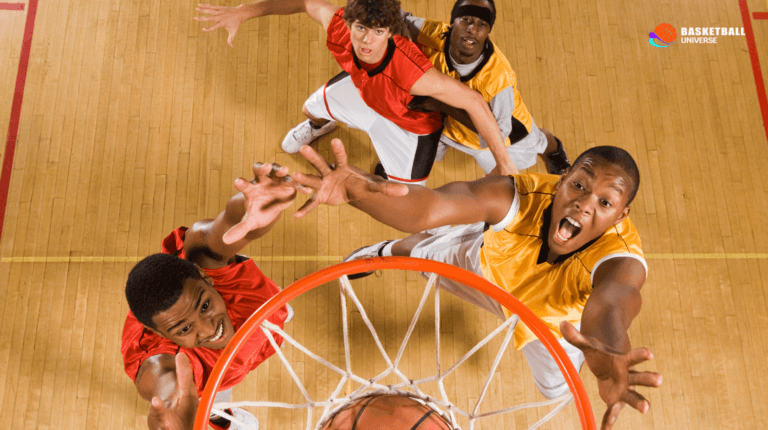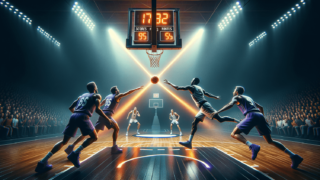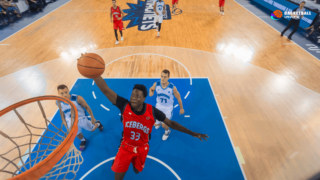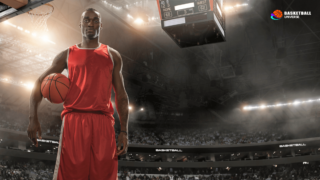
Where Is the Baseline in Basketball?
Written by: Basketball Universe
Last updated:

If you’ve ever found yourself contemplating the ins and outs of basketball, you may have wondered about the significance of the baseline in the game. Well, lucky for you, you’ve arrived at the perfect spot to explore this integral element of the court. In this fun yet professional blog post, titled ‘Where Is the Baseline in Basketball?’, you’ll uncover the location, the rules surrounding it, and its strategic implications. So, roll up your sleeves and get ready to delve into this exciting realm, as we elevate your understanding of the baseline like never before!
Where Is the Baseline in Basketball?
The baseline in basketball refers to the boundary lines at the two shorter ends of the court that run parallel to the backboards. It marks the outer limits of the playing area, and inbounds plays often originate from the baseline, especially after a made basket or when the ball is knocked out of bounds by the opponents. Understanding the baseline’s location and its role in the game is essential for both players and coaches to strategize effectively.
Understanding the Basketball Court
Before we delve deeper into the baseline and its intricacies, let’s establish a solid understanding of the basketball court as a whole. A standard basketball court measures 94 feet in length and 50 feet in width. The court is divided into two halves, with each half containing a three-point arc and a key area, commonly known as the paint. These components all come together, working in harmony to give us the exciting sport we know and love.
The Significance of the Baseline
Now that we have a better understanding of the overall structure of the basketball court, let’s focus on our main spotlight: the baseline. The baseline comes into play in many different aspects of the game, such as determining out-of-bounds situations, inbound plays, and strategic positioning. We will explore these areas in more depth as we journey into the world of the baseline.
Out-of-Bounds Situations
Maintaining Court Boundaries
The baseline is pivotal in maintaining the court boundaries in basketball. When a player has possession of the ball, they must stay within the court boundaries to continue play. If the player or the ball touches the baseline or crosses it, the play is considered out-of-bounds. This results in a turnover, and the opposing team will take possession of the ball from the sidelines or the baseline itself.
Bench and Spectators
The area beyond the baseline serves as a buffer zone, separating the players on the court from the team benches and spectators. This space ensures that the players can compete without unnecessary distractions or safety concerns caused by close proximity to non-players.
Inbound Plays and the Baseline
Inbounding after a Made Basket
Whenever a team scores a basket, the game briefly resets as the opposing team takes possession of the ball. In this scenario, a player from the team gaining possession will stand out of bounds on their baseline and pass the ball to a teammate who is within the court. This inbound pass must occur within five seconds, or the team will be charged with a violation and lose possession.
Out-of-Bounds Restart
If the ball goes out of bounds and the last contact was with an opposing player, the team that retains possession will inbound the ball from the spot nearest to where it went out. In many cases, this spot will be situated along the baseline. Similar to inbounding after a made basket, the inbounder must pass the ball to a teammate on the court within five seconds to avoid a violation.
Endline Situations
A unique scenario involving the baseline occurs when a team has possession of the ball in the last two minutes of the fourth quarter, or during any overtime period. In this case, if a team receives a timeout, they have the option to advance the ball to the half-court line instead of inbounding from their baseline. This benefit is known as the “endline situation,” and it allows teams to set up an advantageous offensive play in critical moments of the game.
Strategic Elements of the Baseline
Baseline Drives
When it comes to offensive play, the baseline offers several strategic opportunities. One such tactic is the “baseline drive”—a player with the ball maneuvers around the defense using the baseline as their route. Because the defender must guard against being beaten by the ball-handler and contend with the position of their help defenders, the baseline can offer a valuable avenue for attacking the rim or collapsing the defense to create open shots for teammates.
Baseline Out-of-Bounds Plays
During out-of-bounds possession, the options for strategic plays off the baseline are virtually endless. Known as “BLOBs” (Baseline Out-of-Bounds plays), these situations enable teams to exploit the vulnerability of defenses during the inbound process. BLOBs can include pick-and-roll plays, screens, and catch-and-shoot opportunities, among others. Executing these plays successfully calls for precise timing, communication, and court awareness from all players involved.
Corner Three-Pointers
The shortest distance between any spot on the three-point arc and the basket is in the corners, where the arc meets the baselines. Shooting from these locations presents various strategic advantages. For example, the “corner three” is a popular tactic in today’s basketball landscape. By positioning a shooter in the corner along the baseline, teams can spread the floor and force defenders to respect their three-point shooting capabilities. This spacing often leads to open lanes for drives or opportunities for kick-out passes to open shooters.
Defensive Strategies on the Baseline
Using the Baseline as an Extra Defender
On the defensive side of the ball, players can utilize the baseline as an extra defender. By angling their body to force the offensive player towards the baseline, the defender can use the boundary to cut off the offensive player’s path to the basket. This acts as a “trap,” potentially leading to turnovers, contested shots, or even offensive fouls called against the player in possession.
Defending Baseline Out-of-Bounds Plays
In BLOB situations, the defense must work cohesively to limit inbound opportunities and deny open shots. This requires exceptional communication, quick rotations, and an understanding of the offensive team’s potential plays. Common defensive strategies include “switching” on screens, denying the inbound pass, and employing various zone defense principles.
Officials, Baseline Calls, and Instant Replay
Officials and Their Responsibility
In every game, officials are tasked with keeping an eye on the baseline to make accurate calls regarding out-of-bounds actions, inbound plays, and possible violations. These responsibilities call for a high level of concentration, accurate interpretations of events in real-time, and excellent communication skills to relay information to players, coaches, and other officials.
Instant Replay and the Baseline
With the advent of instant replay technology, baseline-related calls have become more accurate than ever before. In specific situations, officials may utilize instant replay to review plays and make determinations about whether a call was correct. This technology aids in ensuring that the flow of the game remains fair and enjoyable, while minimizing the impact of human error in officiating.
Throughout our exploration of the baseline in basketball, we have uncovered its importance in numerous aspects of the game. From the fundamentals of defining court boundaries to its influence on tactics and strategy, the baseline serves as an essential component of the sport. Whether you’re a player, coach, or avid fan, having a deeper understanding of the baseline will undoubtedly enhance your appreciation for the game of basketball.
Player Positioning and the Baseline
Players’ positioning on the court is crucial when considering the baseline’s impact on basketball. Proper spacing and court awareness can be incredibly beneficial for both offense and defense. In this section, we will explore how players interact and relate with the baseline and the advantages they can extract from their positioning.
Post Positioning
Post players, typically centers and power forwards, can gain an edge by positioning themselves near or along the baseline. By establishing a strong position in the low post on either side of the key, these players can receive passes, create high-percentage shot opportunities, and draw fouls on the defense. Post players also need to understand how to use the baseline to prevent easy shot opportunities and deny entry passes from their opponents. This balance of offense and defense is essential for successful post play.
Perimeter Positioning
For perimeter players or guards, baseline positioning can provide numerous advantages. By spacing the floor along the baseline, guards help open lanes for drives to the basket and create potential kick-out passes to corner three-pointers or mid-range shots. Guards can also use the baseline to set screens for each other, which leads to mismatches or open shots, and they can take advantage of backdoor cuts from the baseline to catch the defense off guard and secure easy baskets.
Baseline-Related Rule Differences in College Basketball
In college basketball, some baseline-related rules differ from the NBA or FIBA regulations. Knowing these differences is crucial to understand how the baseline can impact gameplay across various levels and leagues.
Restricted Area Arc
College basketball features a restricted area arc positioned four feet from the center of the basket, closer than the NBA’s restricted area, which extends 4 feet and 3 inches. The restricted area arc impacts baseline drives and post play, as defenders cannot draw charges when standing inside this restricted area when a player is driving towards the basket.
Length of the Court
In college basketball, the length of the court is shorter than the NBA and elite FIBA competitions. NCAA Division I men’s and women’s courts measure 94 feet by 50 feet, as does the NBA’s court size, but in some lower divisions and smaller venues, the playing area may also be 84 feet by 50 feet. The shorter distance between baselines can influence the pace of the game and, in turn, affect teams’ strategies related to the baseline.
Training to Leverage the Baseline
Players who seek to take full advantage of the baseline’s various strategic elements must engage in dedicated training and practice. Here, we will discuss some effective training methods and drills to hone specific skills related to the baseline.
Baseline Finishing Drills
To improve baseline drives and finishing at the rim, players can perform finishing drills along the baseline that simulate game-like scenarios. A combination of dribble moves, change of pace, and angled shots will help players develop the required touch and body control to finish around the basket effectively. Additionally, practicing reverse layups and floaters can be beneficial, as these shots require a unique touch and balance to execute.
Inbound Play Drills
Both offensive and defensive players must strive to refine their inbound play performance. For the offense, this may involve drilling set plays with choreographed movements, screens, and passing patterns. Players must learn to set proper screens, move without the ball, and time their passes and cuts for effective execution. On the defensive side, players should focus on communication, switching, and denying inbound passes to disrupt BLOB plays and create turnovers.
Understanding the significance of the baseline in basketball is critical for players, coaches, and fans alike. By continually learning and evolving, related strategies can be optimized and ultimately enhance the overall enjoyment and performance of the sport. Therefore, it is helpful to be aware of different approaches, skills, and rules related to the baseline that will allow you to make the most out of this essential component of the game.
FAQ Section
In this section, we will address frequently asked questions concerning the baseline in basketball. These questions and concise NLP-style answers will provide you with a better understanding of the subject and clarify any potential points of confusion.
1. What is the difference between the baseline and the sideline?
The baseline refers to the boundary lines at the two shorter ends of the basketball court, while the sideline refers to the two longer boundaries on the court’s sides. Both the baseline and sideline determine out-of-bounds areas in basketball.
2. What are some common baseline violations?
Some common baseline violations include stepping on the baseline while inbounding the ball, taking more than five seconds to inbound the ball, and dribbling or stepping out of bounds while in possession of the ball.
3. What is the endline situation in basketball?
The endline situation occurs in the last two minutes of the fourth quarter or during any overtime period when a team receives a timeout. They have the option to advance the ball to the half-court line instead of inbounding from their baseline, providing an advantageous offensive opportunity.
4. How does a player properly inbound the ball from the baseline?
To inbound the ball correctly, a player must stay out of bounds, establish a pivot foot, and pass the ball to a teammate on the court within five seconds. Failure to do so results in a violation and possession turnover to the opposing team.
5. What is a BLOB play?
BLOB stands for Baseline Out-of-Bounds play. It is a strategic offensive play executed when the ball is inbounded from the baseline, including pick-and-roll plays, screens, and catch-and-shoot opportunities.
6. Why are corner three-pointers popular in basketball?
Corner three-pointers are popular because the distance between the three-point arc and the basket is shortest in the corners. This creates high-percentage shot opportunities and allows teams to spread the floor, forcing defenders to respect their three-point shooting abilities.
7. Can a defender draw a charge in the restricted area near the baseline?
No, a defender cannot draw a charge while standing inside the restricted area arc. The restricted area arc is in place to prevent defenders from drawing charges in that specific zone when a player is driving towards the basket.
8. How can offensive players take advantage of backdoor cuts from the baseline?
Offensive players can utilize backdoor cuts from the baseline by faking a move towards the ball and then quickly cutting towards the basket. If timed correctly, this move can catch the defense off guard and result in easy baskets.
9. How do teams defend BLOB plays?
Teams defend BLOB plays by communicating effectively, switching on screens, denying the inbound pass, and employing various zone defense principles. This coordinated approach helps to limit offensive opportunities and disrupt the opposing team’s strategy.
10. How do post players use the baseline to their advantage?
Post players can gain an advantage by establishing a strong position near or along the baseline in the low post. By doing so, they can receive passes, create high-percentage shot opportunities, draw fouls on the defense, and deny easy shots for their opponents.
11. How does the baseline help defenders in basketball?
Defenders can use the baseline as an extra defender by forcing the offensive player towards it, effectively cutting off their path to the basket. Using the baseline as a “trap” can lead to turnovers, contested shots, or offensive fouls.
Officials are responsible for keeping an eye on the baseline, making accurate out-of-bounds calls, and monitoring inbound plays and potential violations. Their ability to concentrate, interpret real-time events, and communicate efficiently is crucial for ensuring fair gameplay.
13. How do the baseline rules differ between college basketball and the NBA?
Some differences in baseline-related rules between college basketball and the NBA include the distance of the restricted area arc and the length of the court itself, which varies across different divisions in college basketball. These differences can influence the pace and strategy of the game across levels and leagues.
Featured Posts
- No pillar pages found.





